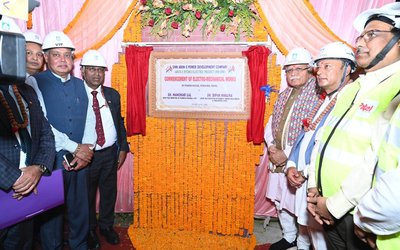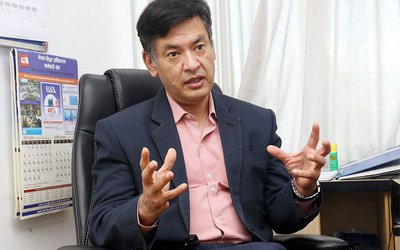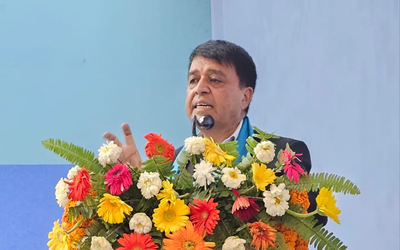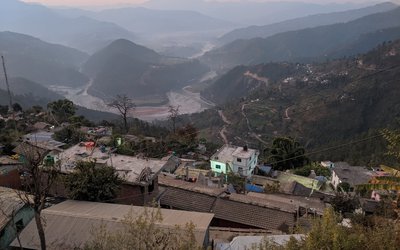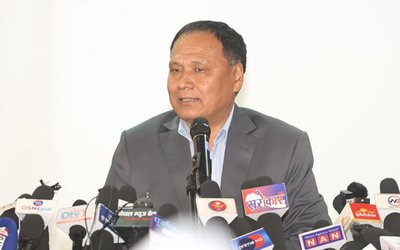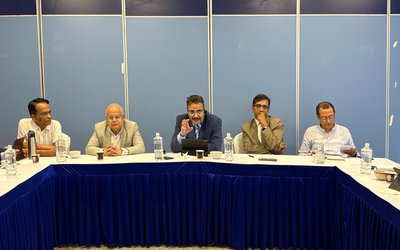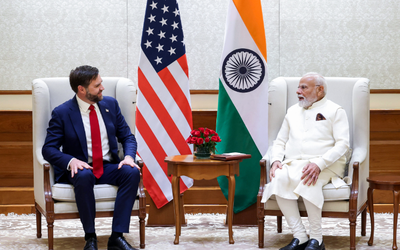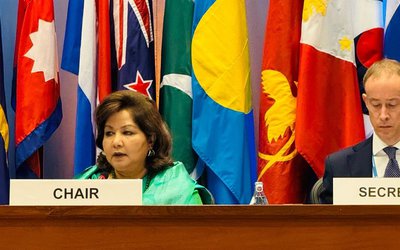
vWith all personnel mobilized in three shifts, the 140 MW Tanahu Hydropower Project constructions is moving forward. The construction pace has accelerated after a few years of delay.
The Tanahu Hydropower project's project manager, Rajbhai Shilpakar, says that the physical infrastructure is progressing satisfactorily. Shilpakar claimed that the project is now making impressive progress despite the lack of explosives and the difficulties in obtaining authorization for tree cutting. The completion of both diversion tunnels on the headworks has made it possible to start building the coffer dam. The completion of the river diversion project, a significant endeavor for the dam's construction, has also cleared the way for the coffer dam's construction.

Because it will assist meet the need for electricity and lessen the import of petroleum goods, the project is economically significant for both Nepal and the Northeast Asian region. Nepal's attempts to lessen the effects of and adjust to climate change will be aided by this project. The risk of flooding downstream will be lessened by the dam.
Nepal has 2800 MW of installed capacity total, which includes solar and hydroelectric. At the moment, the sole reservoir is the 106 MW Kulekhani, constructed within the last forty-three years. THP is therefore strategically important for the NEA system.
Currently, around 1400 MW is produced by NEA and its subsidiary firms, with the remainder power coming from run-of-the-river projects in the private sector. After THP is finished, NEA, which only uses hydropower, will have some supply relief.
Due to the nature of hydropower plants, Nepal's winter generation capacity is only about 1000 MW, despite the country's 1900 MW total electricity consumption. During this period, Nepal's capacity as an Independent Power Producer (IPP) drops to one third. The difference in energy between the dry and lean seasons is substantial.
In this case, the 585.7 Gwh of energy produced by THP is extremely useful. After 11 years, the project produces 489.9 Gwh, compared to 585.7 Gwh in the first 10.
In addition, in less than a year, 507 megawatts of power were added, increasing the total installed capacity to 2858 MW. Moreover, hydropower plants with a 564 MW capacity are presently undergoing testing and commissioning. Within the next two to three months, it is anticipated that projects totaling approximately 3421 will be operational throughout the nation. The solar electricity will account for 107 MW of the total power output. All of the solar power sources won't have storage capacity, though, unlike THP.

A major goal for the Nepal Electricity Authority is the completion of the Tanahu Hydropower Project, according to Kul Man Ghising, Managing Director of NEA. He said that things are moving along at a good pace right now.
"We must accelerate the development of major reservoir and semi-reservoir hydropower projects in order to advance national wealth. As a result, the construction of the 1200 MW Budhi Gandaki, 635 MW Dudhkoshi reservoir hydroelectric project, and 1063 MW Upper Arun semi-reservoir hydropower project has advanced. According to NEA Managing Director Ghising, loan investments from the World Bank and the Asian Development Bank have been made for the Upper Arun and Dudhkoshi hydropower projects, while local investment has progressed the Budhi Gandaki hydropower project.
THP Nature.
The 140 MW Tanahu Hydropower Project is a medium-sized hydroelectric facility. Three packages comprise it: headwork, waterway, and powerhouse. It also covers rural electrification and transmission and power transfer. Large-scale water storage facilities and related transmission lines are part of the project, which aims to evacuate generated power and foster community development in the project areas.
Building diversion tunnels, maintaining the river, dam, and spillway, protecting the reservoir's slope, and constructing an access road surrounding the dam are all included in Package 1. The centerpiece of the headworks area is a dam with a height of 140 meters, a crest of 175 meters, and a volume of about 8,000,000 square meters.
The 140-meter-wide Seti River forms the border between Tanahu district's Rishing Rural Municipality-1 and Byas Municipality-5.
To release sediment that has accumulated in the reservoir, the dam will have sediment flushing features. The tractive force of river flow releases silt through sediment flushing conduits buried in the dam. According to Shilpakar, the reservoir is drained once a year. About 30% of the physical improvement has been made. The package was given to Song Da Corporation and Kalika Construction.
Waterway, powerhouse, and equipment are included in package 2. Construction is currently underway on the hydro-mechanical apparatus, draft gates, tailrace gate, intake gate, steel penstock, sediment flushing facilities, and water level lowering facilities. Along with related civil works, this package also comprises electro-mechanical equipment such maintenance flow producing facilities, turbines, generators, generators, overhead moving cranes, and transformers. Over 55 tangible progress has been made on the project. Sino-Hydro was given the contract.
Four 2480-meter-long Audit Tunnels are among the equipment. Concrete and power excavation have already been finished with excavation. Additionally, the headrace tunnel has been dug out.

A 220 kV double circuit transmission line measuring 37 kilometers is part of Package 3 and runs from the Tanahu generating facility to the recently constructed 220 kV Bharatpur substation. Over 72% of the project's physical progress has been made. Additionally, to link the transmission line to the current network, the new 220 kV Bharatpur substation facilities have been erected.
Thirty-three of the 94 towers have been finished, and 71 towers are still under construction. But only one kilometer of the conductor has been strung.
The project manager said that because they have not been able to obtain permissions from the relevant authorities to chop trees, they are unable to grant access to the remaining places. The project's contractor is the Indian business KEC International.
In the previous three months, the project has advanced significantly. As per Sachen Gautam, who works as a Communication Specialist at Tanahu Hydropower Company Ltd., the project's physical progress was 52 percent as of the conclusion of Mangsir on December 16. According to Gautam, 65 meters of excavation remain to be done in order to reach the main dam's foundation.

It is planned for the project to be finished in May 2026. Because explosives are needed to speed up excavation work, the contractor's performance is still poor. The THP project is extremely lucrative, and the contractor has asked for a one-year extension until May 2027, despite encountering various obstacles prior to the project's start.
The project came out of a virtual slumber due to the initiative of Kenichi Yokoyama, who worked as an ADB Country Director in Nepal from 2013 to 2017.
THP has implemented notable social and environmental safeguards. The project includes rural electrification, which aims to provide reliable grid electricity to people in the affected areas.
The package comprises the construction of two new substations, the augmentation of an existing substation, and the construction of 48 km of 33 kV distribution lines, 344 km of 11 kV distribution lines, and 450 km of 400 V distribution lines. All work under the package has been completed, resulting in Tanahu District achieving 100 percent electrification.
Pushkar Manandhar, senior project officer (Energy) at ADB Nepal Residence Office, stated that the project's progress is expected to accelerate once the issues of explosive scarcity and forest clearance are resolved. ADB has been supporting NEA and the project to speed up the work.
The completion of the Tanahu Hydropower project will significantly improve the current state of power supply in Nepal. The Nepal Electricity Authority has been facing difficulties in maintaining power supply during peak and winter seasons. The project, which has a capacity of 144 MW and is located close to the country's load center, will ensure the quality of the electricity supply.
An Impact Assessment for upgrading the generation license from 127 MW to 140 MW has been prepared. The project manager, Shilpkar, stated that all preparatory work, including the construction of the road at the dam site, cap facilities, equipment and maintenance yard, and office building, has been completed. Additionally, procurement of all major packages has been completed, and implementation is underway.

Despite having a huge surplus of electricity during the rainy season, Nepal faces a significant deficiency of electricity supply during the winter. Most hydropower projects built in the last decade are run-of-the-river type, resulting in a natural disparity in production patterns.
The government has prioritized private sector involvement in hydropower and solar power generation. In the past year, the private sector has been granted permission to produce additional megawatt capacity of solar power and hydropower. MD Ghising reported that power purchase agreements have been concluded with projects worth 3470 MW, and agreements for projects worth 10456 MW have been completed, including 205 MW of solar power.
The completion of the 144 MW THP project, the second semi-storage type project, will provide some relief, despite its relatively small size.
NEA recognizes the project's significance in Nepal's electricity sector and is working diligently to complete it on time. According to MD Ghising, they are addressing issues such as explosives and trees at higher levels.
The project was delayed for nearly two years due to the termination of the contractor for lot 1, the selection of a new contractor, and the COVID-19 pandemic. Completing the project on time will have a significant impact on load management.
According to project manager Shilpkar, early completion can help alleviate load pressure during the winter. This is the second storage project after Kulekhani.
Kiran Kumar Shrestha became managing director a few months ago. He has been visiting the site to accelerate construction work.
Currently, Song Da Corporation, Vietnam-Kalika Construction (P) Ltd, Nepal (JV) is constructing package one of the Headwork of Tanahu Hydro-power Project, including the diversion of the river.
Under the second package, the Chinese contractor Syno Hydro has made significant progress in constructing the tunnel, power house, and supplying hydro-mechanical and electro-mechanical components.
Thanks to the hard work of former MD Pradeep Kumar Thike, the contractor of the second package has made good progress ahead of schedule.
The project was completed on time. After terminating the contract with CMC di Ravenna, Italy in April 2019, the project had to restart the bidding process from the beginning.
The procurement of Package 1 (Head works) has been significantly delayed due to the unavoidable termination of the contract with CMC di Ravenna, Italy, and the rejection of all bids received for the re-bidding. The bids were substantially non-responsive to the requirements of the bidding documents.
Given his experience working on a number of hydropower projects, the current MD Shrestha is likely to push the contractor to make progress.
The THP is expected to produce 587.7 gigawatt-hours of energy in its first 10 years of operation. During the dry season, the project can generate energy for six hours per day.
The project's total cost is estimated to be 505 million USD, and funding arrangements have been made after signing loan agreements with ADB, JICA, and EIB.

ADB, the European Investment Bank, JICA, and the Nepal government are investing a total of USD 505 million in Nepal's energy sector.
Thanks to ADB's financing, Nepal has made significant progress in the past decade. The THP, Nepal's second storage project, is progressing well and paving the way for ADB to support Dudhkoshi hydropower, Nepal's largest storage project.
ADB is a key partner in Nepal's energy sector development, focusing on supporting NEA's expansion of generation, transmission, and distribution capacity.
NEA has made significant progress in transmission projects and distribution capacity building projects funded by ADB in the past year. Examples include the completion of the Kali-Gandaki corridor and the Bharatpur Bardaghat 220 kV transmission line. The Bardaghat-New Butwal 220 kV transmission line project is now in its final stage of completion.
The project is progressing at a good pace. Arnaud Cauchoi, Country Director of the Asian Development Bank Country Mission, expressed hope that the Tanahu project will begin generating power as scheduled.
The ADB funded the 144 MW Kali Gandaki 'A' project, which is still strategically important for balancing power during peak periods, until the completion of the 456 MW Upper Tamakoshi project. Additionally, the ADB supported the Khimti hydropower projects.
“ ADB is our main partner in the energy sector, and NEA seeks more support from ADB for generation projects such as the Dudh Koshi Storage and 440 kV Butwal-Kohalpur Transmission Line Project. 'We will complete the 140 MW Tanahu project on schedule,' said Kul Man Ghising, Managing Director of NEA.
Over the last fifty years, ADB has made significant contributions to building Nepal's infrastructure, including transportation, air and highways, and hydropower.
ADB has invested in strengthening Nepal's transmission and distribution networks since 1972 through loans, grants, and technical assistance. ADB has invested in strengthening Nepal's transmission and distribution networks since 1972 through loans, grants, and technical assistance. In the past 15 years, ADB has focused on expanding and improving these infrastructures.
Various river corridors now have transmission lines that bring electricity from private sector projects to the national grid system. These include the Kaligandaki, Modi, Khimti, Dordi, and Koshi corridors. The Hetouda (Bharatpur) Wardghat 220 kV transmission line and Marsyangadi (Kathmandu 220 kV) transmission line projects have also been completed.
Jan Hansen, Principal Economist at ADB Nepal's Resident Mission, stated that ADB has been supporting Nepal's hydropower sector to achieve the goal of prosperous, inclusive, resilient, and sustainable growth. He mentioned that storage projects like THP are likely to support Nepal in achieving higher economic growth.
As ADB celebrates 50 years in Nepal, contributing immensely to the energy sector, the completion of the Tanahu Hydropower Project by 2027 is crucial.

Keshab Poudel
Poudel is the editor of New Spotlight Magazine.
- KUL MAN GHISING: Bowing Down To The People
- Apr 13, 2025
- POLITICAL VIOLENCE: Culture of Impunity
- Apr 11, 2025
- PM OLI MEETS PM MODI: No Progress
- Apr 09, 2025
- PM OLI’S THAILAND VISIT: Flip Flop
- Apr 08, 2025
- FM Dr. Deuba’s India Visit: Mission Aborted
- Mar 26, 2025
